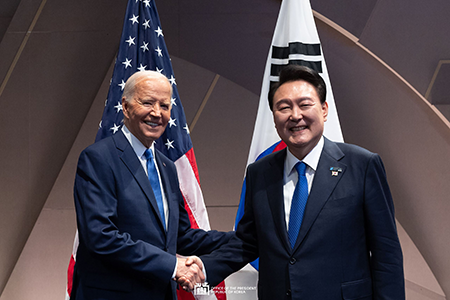"I greatly appreciate your very swift response, and your organization's work in general. It's a terrific source of authoritative information."
North Korea, South Korea Strengthen Deterrence
September 2024
By Kelsey Davenport
North Korea deployed launchers for nuclear-capable missiles along its southern border after South Korea and the United States announced new guidelines for strengthening U.S. extended nuclear deterrence.

South Korean President Yoon Suk Yeol and U.S. President Joe Biden announced the new guidelines for responding to North Korean threats during a July 11 meeting in Washington. The joint statement described the guidelines document as providing a “solid foundation” for enhancing South Korean-U.S. cooperation on extended nuclear deterrence.
The guidelines were crafted by the Nuclear Consultative Group, a body Biden and Yoon established in 2023 to increase South Korean participation in U.S. extended nuclear deterrence decision-making. (See ACT, May 2023.)
Although the presidents did not go into detail about the nature of the guidelines, a U.S. Defense Department press release on July 11 said the document will “provide principles and procedures to assist alliance policy and military authorities in maintaining effective nuclear deterrence policy and posture.”
Yoon said that, as a result of the guidelines and the work of the consultative group, U.S. nuclear assets will be “specifically assigned” to Korean peninsula missions. He described the move as an upgrade to the alliance.
Vipin Narang, the acting U.S. assistant secretary of defense for space policy and co-chair of the consultative group, said on July 16 that the guidelines will allow the group to “evolve with the threat environment.”
Narang, speaking to VOA Korean Service, said that South Korea and the United States approach extended deterrence as “equal partners,” but reiterated that only the U.S. president will be able to authorize the use of nuclear weapons.
In their statement, Biden and Yoon also called for the consultative group to make further progress on several issues, including South Korean conventional support for U.S. nuclear operations “through conventional-nuclear integration” and “nuclear consultation processes in crises and contingencies.”
North Korea’s state-run Korean Central News Agency (KCNA) on July 13 described the announcement as a demonstration of South Korean and U.S. “sinister intentions to step up preparation for a nuclear war” with North Korea. Its statement said that Seoul and Washington are driving Pyongyang to “further improve its nuclear deterrent readiness and add important elements” to its nuclear arsenal.
Several weeks later, North Korea announced the deployment of the 250 missile launchers to military units stationed near the border with South Korea.
In an Aug. 4 speech marking the delivery, North Korean leader Kim Jong Un described the systems as “new-type tactical ballistic missile launchers” for the military’s “new core offensive weapon.” He said that North Korea is “attaining [its] first-stage goal of building missile forces in the first line units on the front” with South Korea.
Images from the event suggest that the launchers are designed for the Hwasong-11D, a short-range ballistic missile that North Korea says is nuclear capable. Each launcher can carry four missiles. Independent assessments of North Korea’s nuclear arsenal suggest that the country has assembled an estimated 50 warheads.
Kim blamed U.S. military activity for North Korea’s decision to deploy the launchers. He said that as the “U.S.-led alliance” evolves into a “nuclear-based military block, the military security environment surrounding” North Korea is changing drastically and that Pyongyang cannot “rest content with its current level of war deterrent.” He said that South Korea has “grown reckless enough” to want to share U.S. nuclear weapons.
North Korea later accused the United States and South Korea of using joint military exercises as “preparation for a war.” An Aug. 18 commentary in KCNA rejected the U.S. description of the annual exercises as “defensive” and described the drills as “offensive and provocative.”
South Korea and the United States announced previously that the annual August drills, called Ulchi Freedom, would not include responding to a North Korean nuclear attack. But South Korea announced separate plans to hold its own nuclear response training during the joint exercise.
The South Korean unilateral exercises also included responding to “gray zone provocations,” such as the trash-filled balloons that North Korea sends over the border and false information spread by “anti-state forces” within South Korea, and defending infrastructure from attacks, Yoon said in an Aug. 19 speech.
Yoon raised similar concerns about divisive propaganda during an Aug. 15 speech laying out South Korea’s new strategy for unification with North Korea.
Yoon reaffirmed South Korea’s commitment to “peaceful unification based on freedom and democracy,” even though North Korea abandoned the goal of unification last year. (See ACT, January/February 2024.)
To achieve unification, Yoon said South Korea must pursue “three key undertakings” of building the capabilities to pursue “freedom-based unification,” fostering a “strong desire for unification” among the North Korean people, and acting in solidarity with the international community.
